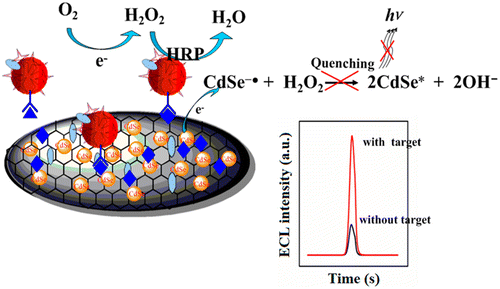Jianguo Li*†‡(李建国)
† College of Chemistry, Chemical Engineering & Materials Science, Soochow University, Suzhou 215123, China
‡ The Key Lab of Health Chemistry & Molecular Diagnosis of Suzhou, Suzhou 215123, China
Environ. Sci. Technol. 2015, 49, 5013–5020
A multiple signal amplification strategy was designed for an ultrasensitive competitive immunoassay for Hg2+. This strategy was achieved using graphene conjugated with a large number of CdSe quantum dots to enhance the basal signal and enormous horseradish peroxidase (HRP) labeled with gold nanoparticles (AuNPs) to consume the coreactant H2O2 generated in situ. The immunosensor was constructed by immobilization of coating antigen on poly(diallyldimethylammonium chloride)–graphene–CdSe composites (PDDA–GN–CdSe), and a strong electrochemiluminescence (ECL) signal was obtained. When the immunosensor was immersed in antibody–AuNPs–HRP composites, the ECL signal greatly decreased, which was ascribed to the bound enzyme on the electrode surface. The self-produced coreactant H2O2 was consumed by o-phenylenediamine in the presence of enzyme, effectively decreasing the ECL intensity from the quantum dots. The Hg2+ in solution and the corresponding coating antigen competed for the limited antibody, and thus, the ECL intensity was linearly dependent on the logarithm of the mercury(II) concentration from 0.2 to 1000 ng mL–1 with a detection limit of 0.06 ng mL–1. The immunoassay exhibited good stability and accuracy and acceptable reproducibility, indicating that it provides a promising approach for the detection of trace mercury and other small molecular compounds in environmental samples.

链接:
//pubs.acs.org/doi/abs/10.1021/acs.est.5b00690